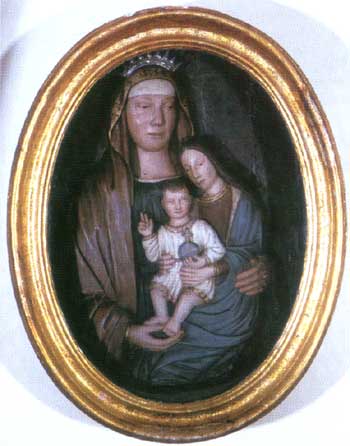The devout
bust-length image of The Suffering Christ which forms the main
side of a two-faced icon known as the Christus Passus, is another
painting of good quality which might have belonged to the 1530
treasure. Its harsh realism points to late fifteenth or early
sixteenth century Spain, but may also be an indication of Flemish
influence. The unusual shape suggests that the painting was
trimmed to fit the frame of the gilt-silver monstrance-type
support donated, in the early seventeenth century by the Florentine
Knight, Fra Aloysius Mazzingus, Bailiff of Santo Stefano (1607-1623)
(26).
The oval polychrome wood medallion of St. Anne, in the church
of the saint at Fort St. Elmo, is slightly better documented.
A late eighteenth century source claims that it came from Rhodes
and was cut into its present shape around 1729 (27).
It was originally of square format and carried the arms of the
Master Villiers de L'Isle Adam. The date 1521-1534, suggested
by this information, seems to be corroborated by the stylistic
evidence, which reflects the cross-fertilization of artistic
ideas characteristic of the late Gothic period. The provenance
is unknown but the general feeling is French. My suggestion
is that this was the altarpiece of the chapel on board the caracca
Sant'Anna commissioned in Nice in 1522 by Villiers de L'Isle
Adam. The ship was dismantled in 1548 by the Master Juan d'Homedes
(1536-1553) who built Fort St. Elmo and dedicated its church
to St. Anne in 1552 (28).
The caracca, popularly known as the Gran Caracca di Rodi, was
a remarkable ship whose size and tonnage (it was reputed to
weigh more than 2000 tons) made it a fearsome war machine. The
general feeling was that it was unsinkable. It was sheeted in
lead, had six decks, two of them below water-level, and its
sails area was exaggeratedly claimed to be large enough to cover
Fort St. Angelo when it entered or left the Grand Harbour.
|
The ship was also remarkably ornate
and, in addition to a spacious chapel, it was decorated with
several statues of saints among which the most famous was an
over 2m. high St. John the Baptist. This statue has survived
and later generations of Knights it revered as a sacred relic.
It is now preserved in the conventual church, in the Chapel
of San Carlo Borromeo (29).
|
|
| Relief of St. Anne with
Virgin and Child. Stuccoed, gessoed, and painted wood.
Chapel of St. Anne, Fort St. Elmo. Photo credit: The Marquis
Cassar de Sayn. |
|
|
| Unknown late 16th/or early
17th century Master, The Gran Carracca of Rhodes. Oils
on canvas. Sanctuary Museum, Zabbar. Photo credit: The
Marquis Cassar de Sayn. |
|
|
[26] It is
emblazoned with his armorial shield. The icon of the Virgin of Sorrows,
on the reverse side of the monstrance, is a late eighteenth century
work in the style of Antoine Favray, but it possibly replaces an earlier
icon.
[27] AOM 1953, f. 218v.
[28] G.F. Abela, Della Descrittione di Malta, Malta 1647, 105.
[29] Also known as the Chapel of the Holy Relics. |
|

